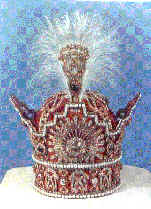|
|
Address: Bank Markazi Iran, Ferdowsi Ave., Tehran, Iran
Tel.: (98) (21) 6446-3785
Opening hours: 14-16:30, Saturday to Tuesday
Type of Museum: Specialized
Type of objects: Jewelry
The incomparable "Treasury of the National Jewels" is a collection of the most expensive jewels of the world, collected over centuries.
Every piece of this collection, is a reflection of the tumultuous history of this great nation, and the result of the creativity and artistry of the residents of this land. Each piece recalls memories of bitter-sweet victories and defeats, of the pride and arrogance of rulers, who were powerful or weak. The value of objects in Treasury of National Jewels is not limited to their economic value, but is also a reflection of the creativity and taste of Iranian craftsmen and artists over different eras of history, and represent the artistic and cultural heritage of the vast country of Iran.
These jewels were decorations for rulers, during the past eras, and often showed the glory and extravagance of their courts, as well as their power and wealth.
There is no information about the quality and quantity of the treasuries before Safavid period. It can be said that recorded history of Treasury of Jewels began with Safavid Monarchs. In short, history of the amassment of the present collection is as follows:
Before Safavid dynasty, certain jewels existed in government treasuries, but it was with Safavid dynasty that foreign travelers ( Jean-Baptist Tavernier, Chevalier Chardin, Shirley brothers, George Mainwaring and others) began to mention these treasuries. Safavid Monarchs, over two centuries ( 1502 to 1735 AD), started to collect rare and beautiful gems. Gem specialists of Safavid Court brought fine stones to Isfahan, capital of Iran at that time, from the markets of India, Ottoman Empire and European countries like France and Italy.
After the rule of Shah Soltan Hossein and entry of Mahmoud, the Afghan, to Iran, treasury was scattered, and some of the jewels were taken by Mahmoud, the Afghan, and transferred to Ashraf, the Afghan. After entry of Shah Tahmaseb 2 and Nadir to Isfahan, these Jewels fell in to the hands of Nadir, and thus were preserved inside the country. Later, in order to regain the jewels that have been transported to India, Nadir wrote several letters to the Indian Court, but did not receive any favorable reply.
After Nader's victory in India in 1745 AD, Mohammad Shah delivered cash amounts, Jewels and weapons to Nadir as booty. Part of treasures which were obtained in India never reached Iran, and were lost during transportation.
According to traditions of that time, After returning to Iran, Nadir sent part of the booty as gifts to neighboring rulers. He also presented some beautiful and rare objects to Holy Shrine of Imam Reza, while some were distributed among soldiers of his army.
After assassination of Nadir in 1747 AD, Ahmad Beg Afghan Abdali, one of his commanders, looted the treasury of Nadir. One of the famous Jewels that let Iran at this time and never returned, was the famous " Kouh-e-Nur " (mountain of light) diamond. This diamond passed on to the hands of Ahmed Shah Durrani and then to Ranjit Singh of Punjab. After his defeat by the British Government, "Kouh-e-Nur" diamond fell in to the hands of East India Company, and in 1850 AD it was given to Queen Victoria as a gift.
Then, there was no major change in Treasury. During Qajar period, Treasury was collected and recorded and some of the stones were mounted on Kiani crown, the Nadir Throne, the globe of jewels, and the peacock Throne (or the sun Throne).
Two other items that were gradually added to this Treasury, are turquoises, the genuine precious stone of Iran, extracted from the local turquoise mines, and the other are pearls, hunted from the Persian Gulf.
Present collection was constructed in 1955 AD. In 1960 AD by the establishment of Bank Markazi Iran, Treasury was transferred and deposited with Central Bank. Now it is also safeguarded by Bank Markazi Jomhouri Islamic Iran.
This collection involved great Jewels that named:
1- Gold Decanter
2- These enameled rings are decorations for the horses tail.
3- Gold and Enamel Container
4- A Saddle Horn
5- Gold Box decorated with Diamonds
6- Qalyan
7- Golden Candlestick
8- Jar of a water pipe
9- Turquoises Cup
10- Hat of Abbas Mirza
11- Emerald Tiara
12- Pearl Brooches
13- The Emerald Snuff-Box
14- Crown used by Pahlavi
15- Darya-i-Nur Diamond
16- Nadir's Aigrette
17- Crown used by Farah
18- The Kiani Crown
19- The Globe of Jewels
20- Peacock Throne
Also, large mount of various objects decorated and decorated marshal instruments such as swords, dagger and shield, ... and some inlaid in Jewels tools such as cup, basin, ewer, tray and...

|
|

